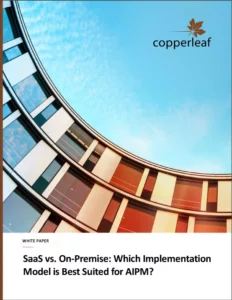SaaS vs. On-Premise: Which Implementation Model is Right For Your Organization?
As part of an evaluation of Asset Investment Planning and Management (AIPM) solutions—or any enterprise software application for that matter—there are two key questions to consider:
- Which licensing model is best suited to your organization—Software as a Service (SaaS) or a perpetual license?
- Where should you run the application—in your own data centers or hosted in the cloud?
Each of these options presents its own unique advantages, and it’s important to understand the differences in order to make an informed decision about which is the best choice for your business.
Licensing Models & Hosting Options: A Brief Introduction
SaaS systems are hosted in the cloud, allowing organizations to simply turn the service on or off without any investment in hardware or support staff. The client pays a recurring fee to use the software for a specified period. This includes the right to use the software, the support and maintenance fees, and the costs of the cloud-based platform.
With the proliferation of Infrastructure as a Service (IaaS) companies such as Amazon Web Services and Microsoft Azure Cloud Services, the popularity of the SaaS model has dramatically increased in recent years. Hosting in the cloud provides immediate benefits to the end client because it alleviates the need for businesses to invest in internal IT resources and equipment to run and maintain their software applications.
A perpetual license has a higher upfront cost as it is a one-time charge that entitles the client to use the software forever. With a perpetual license, the client typically pays an ongoing support and maintenance fee to keep the software up to date and receives updates on the product as technology platforms evolve. Though clients technically have the right to use the license forever, the software will eventually become obsolete without ongoing support and maintenance.
Whereas SaaS systems are always hosted in the cloud, perpetual licenses can either be installed in the cloud or on-premise, which means the software is installed on a computer or server that the client owns and supports. While perpetual licenses have traditionally been installed on-premise, many software vendors, including Copperleaf™, also give clients the option of purchasing a perpetual license and hosting it on a cloud-based platform.
This again has advantages of reducing the internal IT support costs and upfront costs for the purchase and installation of the infrastructure, but may not be suitable for everyone. Organizations that handle large quantities of personal data, for example, may have regulations that stipulate the data may not be stored in the cloud or be accessible to parties outside the organization. If this is the case, the system may need to be installed on-premise as a SaaS solution may not be compliant.
All in all, there are many things to consider, and no one-size-fits-all solution. It all comes down to understanding the pros and cons of the various options to decide what makes the most sense for your organization.

In our latest white paper, we explore a number of factors to consider, including:
- Cost
- Deployment Time
- Software Customization
- Agility and Scalability
- Security and Compliance
Download our SaaS vs On-Premise – Which Implementation Model Is Best Suited For AIPM? white paper to gain practical advice to help you choose the implementation model that is right for your organization.

